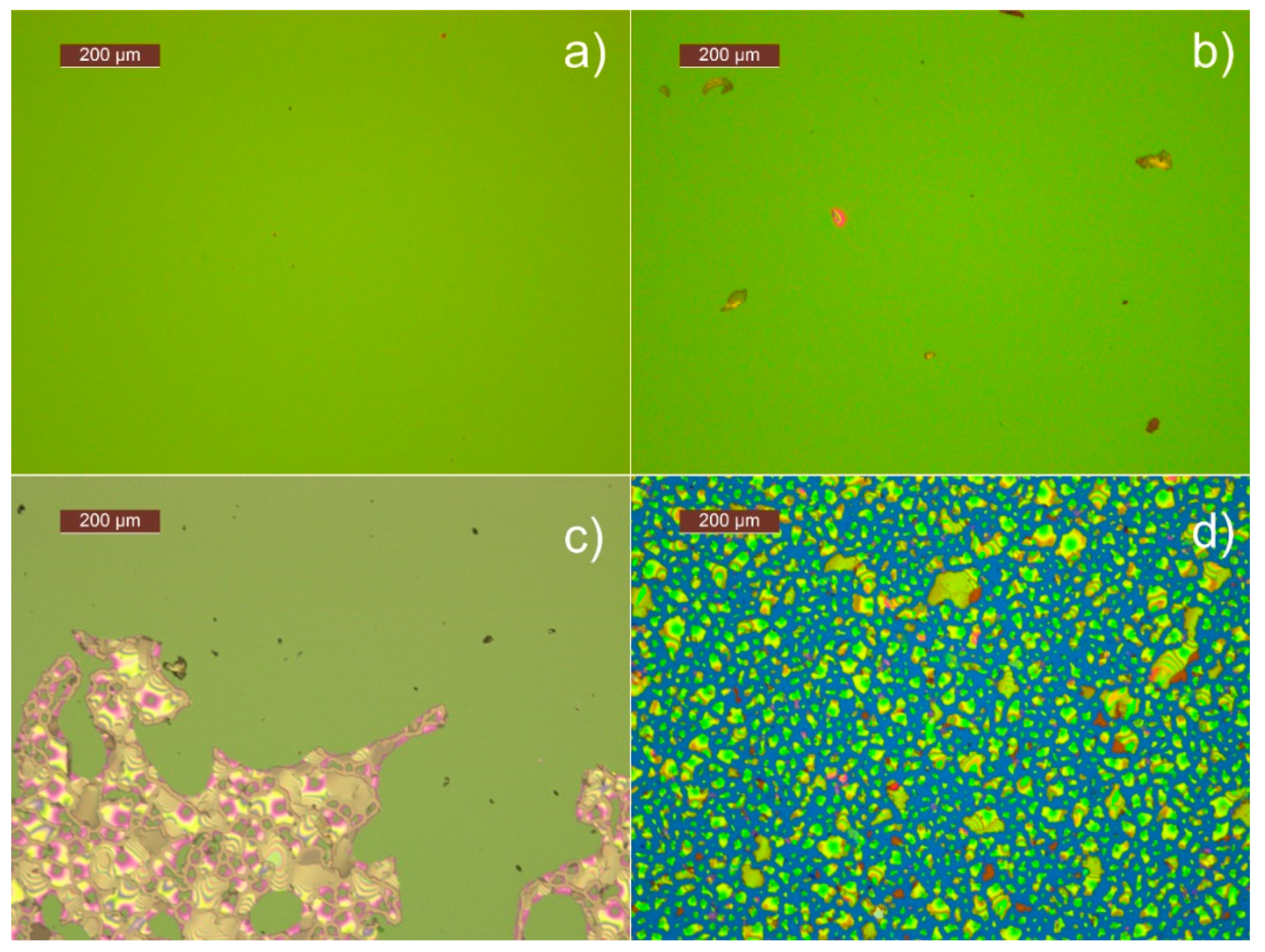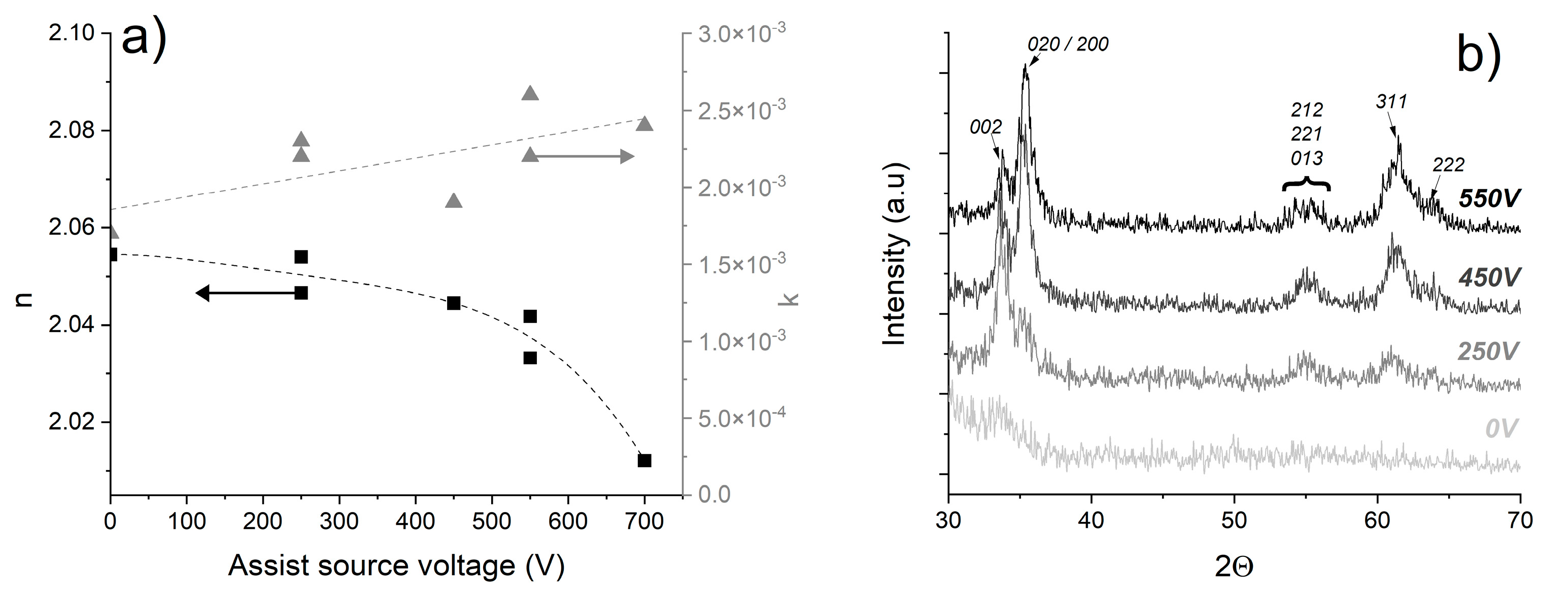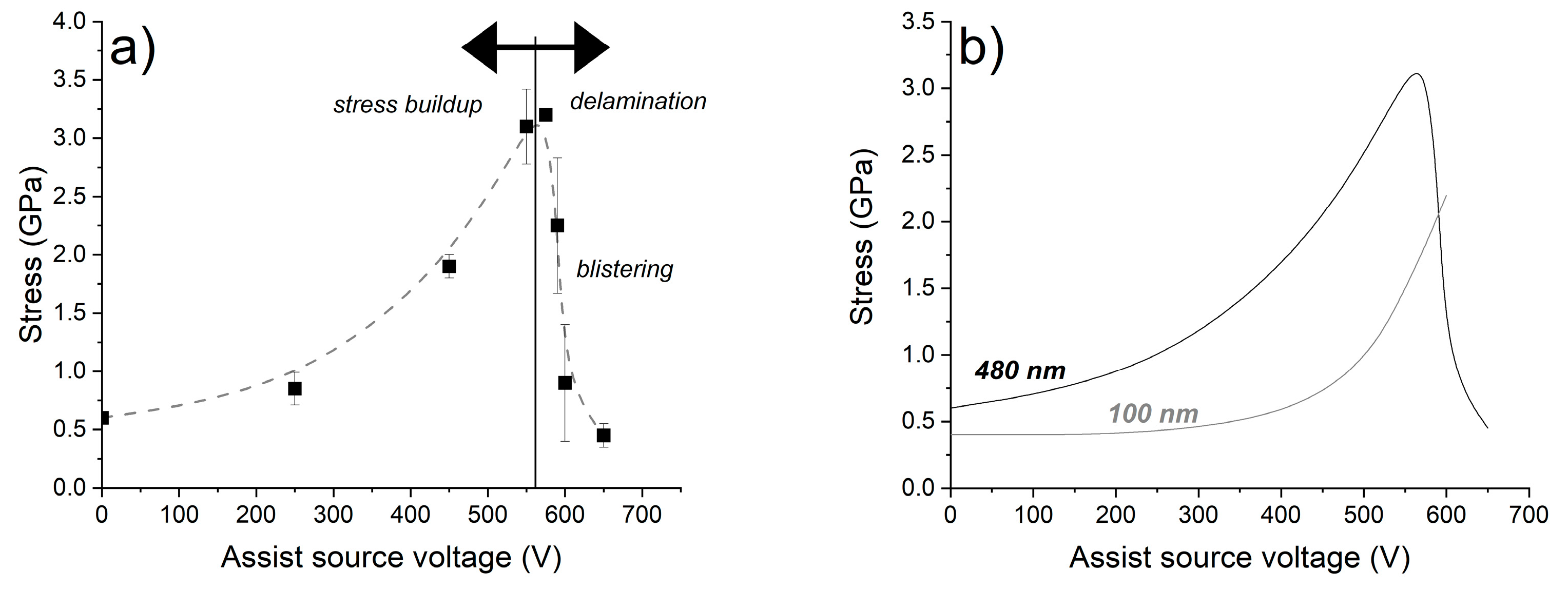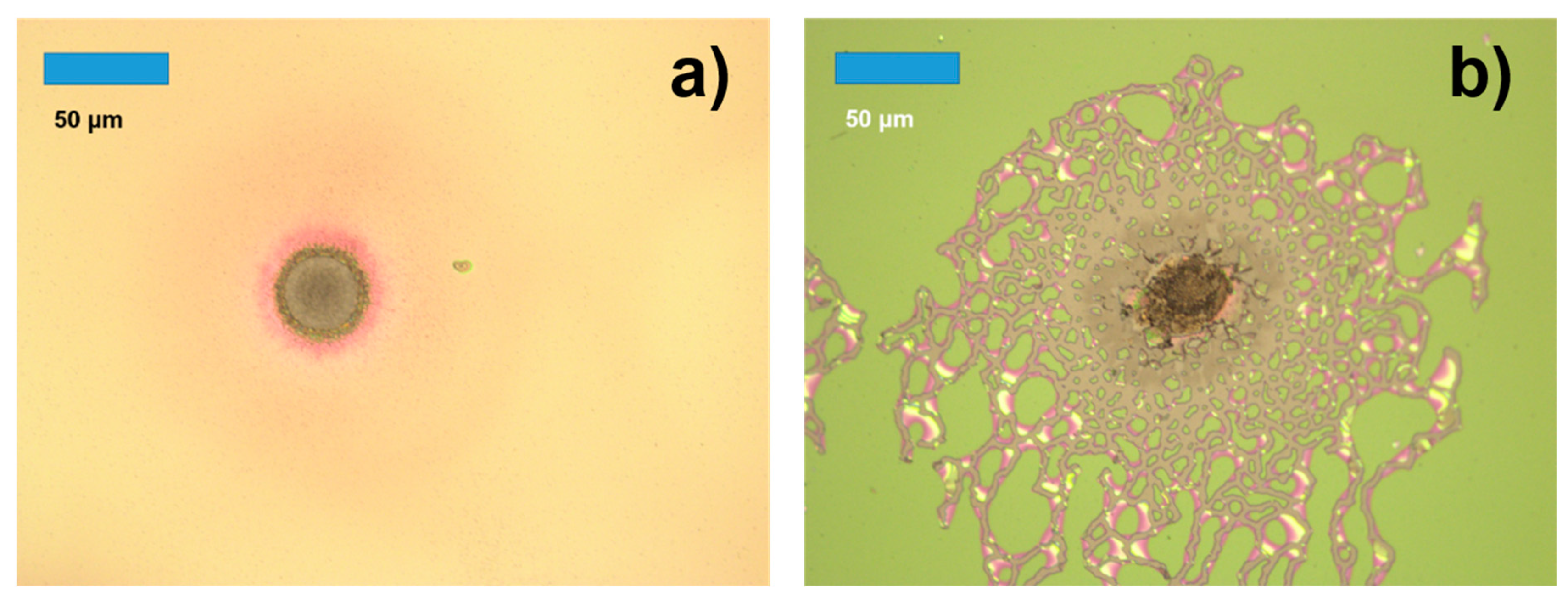Influence of the Secondary Ion Beam Source on the Laser Damage Mechanism and Stress Evolution of IBS Hafnia Layers
Abstract
1. Introduction
2. Materials and Methods
2.1. HfO2 Thin Film Deposition
2.2. Film Stress Measurement
2.3. Thin Film Crystal Structure
2.4. Optical Properties and Laser-Induced Damage Testing
3. Results
3.1. Thin-Film Structure
3.2. Thin Film Stress
3.3. Laser-Induced Damage Threshold
4. Discussion
5. Conclusions
Author Contributions
Funding
Institutional Review Board Statement
Informed Consent Statement
Data Availability Statement
Conflicts of Interest
References
- Kaiser, N.; Pulker, H.K. Optical Interference Coatings; Springer: Berlin, Germany, 2003. [Google Scholar]
- Ristau, D. Laser-Induced Damage in Optical Materials; CRC Press: Boca Raton, FL, USA, 2014. [Google Scholar]
- Langdon, B.; Patel, D.; Krous, E.; Rocca, J.J.; Menoni, C.S.; Tomasel, F.; Kholi, S.; McCurdy, P.R.; Langston, P.; Ogloza, A. Influence of process conditions on the optical properties HfO2/SiO2 thin films for high power laser coatings. In Laser-Induced Damage in Optical Materials: 2007; SPIE: Bellingham, WA, USA, 2007; Volume 6720, p. 67200X. [Google Scholar]
- Liu, H.; Jiang, Y.; Wang, L.; Li, S.; Yang, X.; Jiang, C.; Liu, D.; Yi-Qin, J.; Zhang, F.; Chen, D. Effect of heat treatment on properties of HfO2 film deposited by ion-beam sputtering. Opt. Mater. 2017, 73, 95–101. [Google Scholar] [CrossRef]
- Stolz, C.J.; Thomas, M.D.; Griffin, A.J. BDS thin film damage competition. In Laser-Induced Damage in Optical Materials: 2008; SPIE: Bellingham, WA, USA, 2008; Volume 7132, p. 71320. [Google Scholar] [CrossRef]
- Gusev, E.; Cartier, E.; Buchanan, D.; Gribelyuk, M.; Copel, M.; Schmidt, H.; D’Emic, C. Ultrathin high-K metal oxides on silicon: Processing, characterization and integration issues. Microelectron. Eng. 2001, 59, 341–349. [Google Scholar] [CrossRef]
- Choi, J.; Mao, Y.; Chang, J. Development of hafnium based high-k materials—A review. Mater. Sci. Eng. R Rep. 2011, 72, 97–136. [Google Scholar] [CrossRef]
- Cevro, M.; Carter, G. Ion beam sputtering and dual ion beam sputtering of titanium oxide films. J. Phys. D Appl. Phys. 1995, 28, 1962–1976. [Google Scholar] [CrossRef]
- Davis, C. A simple model for the formation of compressive stress in thin films by ion bombardment. Thin Solid Films 1993, 226, 30–34. [Google Scholar] [CrossRef]
- Bilek, M.M.M.; McKenzie, D.R. A comprehensive model of stress generation and relief processes in thin films deposited with energetic ions. Surf. Coatings Technol. 2006, 200, 4345–4354. [Google Scholar] [CrossRef]
- Bischoff, M.; Nowitzki, T.; Voß, O.; Wilbrandt, S.; Stenzel, O. Postdeposition treatment of IBS coatings for UV applications with optimized thin-film stress properties. Appl. Opt. 2014, 53, A212–A220. [Google Scholar] [CrossRef] [PubMed]
- Rammula, R.; Aarik, J.; Mändar, H.; Ritslaid, P.; Sammelselg, V. Atomic layer deposition of HfO2: Effect of structure development on growth rate, morphology and optical properties of thin films. Appl. Surf. Sci. 2010, 257, 1043–1052. [Google Scholar] [CrossRef]
- Wei, Y.; Xu, Q.; Wang, Z.; Liu, Z.; Pan, F.; Zhang, Q.; Wang, J. Growth properties and optical properties for HfO2 thin films deposited by atomic layer deposition. J. Alloys Compd. 2018, 735, 1422–1426. [Google Scholar] [CrossRef]
- Stenzel, O.; Wilbrandt, S.; Kaiser, N.; Vinnichenko, M.; Munnik, F.; Kolitsch, A.; Chuvilin, A.L.; Kaiser, U.; Ebert, J.; Jakobs, S.; et al. The correlation between mechanical stress, thermal shift and refractive index in HfO2, Nb2O5, Ta2O5 and SiO2 layers and its relation to the layer porosity. Thin Solid Films 2009, 517, 6058–6068. [Google Scholar] [CrossRef]
- Yoon, S.; Kang, S.; Jung, W.; Kim, S.-W.; Yoon, D. Effect of assist ion beam voltage on intrinsic stress and optical properties of Ta2O5 thin films deposited by dual ion beam sputtering. Thin Solid Films 2008, 516, 3582–3585. [Google Scholar] [CrossRef]
- Hopcroft, M.; Nix, W.D.; Kenny, T.W. What is the Young’s Modulus of Silicon? J. Microelectromech. Syst. 2010, 19, 229–238. [Google Scholar] [CrossRef]
- Gischkat, T.; Schachtler, D.; Balogh-Michels, Z.; Botha, R.; Mocker, A.; Eiermann, B.; Günther, S. Influence of ultra-sonic frequency during substrate cleaning on the laser resistance of antireflection coatings. In Laser-induced Damage in Optical Materials 2019; SPIE: Bellingham, WA, USA, 2019; Volume 11173, p. 1117317. [Google Scholar]
- Botha, R.; Bischof, D.; Vetsch, B.; Scherrer, U.; Michler, M.; Rinner, S.; Ettemeyer, A.; Ziolek, C. Investigation of the ageing effects exhibited by AR coatings exposed to ultraviolet laser irradiation. In Laser-Induced Damage in Optical Materials 2016; SPIE: Bellingham, WA, USA, 2016; Volume 10014, p. 100141L. [Google Scholar] [CrossRef]
- Fu, W.-E.; Chang, C.-W.; Chang, Y.-Q.; Yao, C.-K.; Liao, J.-D. Reliability assessment of ultra-thin HfO2 films deposited on silicon wafer. Appl. Surf. Sci. 2012, 258, 8974–8979. [Google Scholar] [CrossRef]
- Anders, A. A structure zone diagram including plasma-based deposition and ion etching. Thin Solid Films 2010, 518, 4087–4090. [Google Scholar] [CrossRef]
- Tan, T.; Liu, Z.; Lu, H.; Liu, W.; Tian, H. Structure and optical properties of HfO2 thin films on silicon after rapid thermal annealing. Opt. Mater. 2010, 32, 432–435. [Google Scholar] [CrossRef]
- Wesch, W.; Wendler, E. Ion Beam Modification of Solids; Springer Series in Surface Science 61; Springer: Cham, Switzerland, 2016. [Google Scholar]
- Yao, J.; Shao, J.; He, H.; Fan, Z. Effects of annealing on laser-induced damage threshold of TiO2/SiO2 high reflectors. Appl. Surf. Sci. 2007, 253, 8911–8914. [Google Scholar] [CrossRef]
- Abromavičius, G.; Kičas, S.; Buzelis, R. High temperature annealing effects on spectral, microstructural and laser damage resistance properties of sputtered HfO2 and HfO2-SiO2 mixture-based UV mirrors. Opt. Mater. 2019, 95, 109245. [Google Scholar] [CrossRef]





| Series | Layer Thickness | Assisting Ion Beam Source | |
|---|---|---|---|
| [nm] | Uassist [V] | Iassist [mA] | |
| A | 480 | 0 | 0 |
| 250, 450 | 100 | ||
| 550, 575 | 150 | ||
| 590 | 160 | ||
| 600 | 166 | ||
| 650 | 183 | ||
| 700 | 200 | ||
| B | 100 | 0 | 0 |
| 450 | 100 | ||
| 550 | 150 | ||
| 600 | 166 | ||
Publisher’s Note: MDPI stays neutral with regard to jurisdictional claims in published maps and institutional affiliations. |
© 2020 by the authors. Licensee MDPI, Basel, Switzerland. This article is an open access article distributed under the terms and conditions of the Creative Commons Attribution (CC BY) license (http://creativecommons.org/licenses/by/4.0/).
Share and Cite
Stevanovic, I.; Balogh-Michels, Z.; Bächli, A.; Wittwer, V.J.; Südmeyer, T.; Stuck, A.; Gischkat, T. Influence of the Secondary Ion Beam Source on the Laser Damage Mechanism and Stress Evolution of IBS Hafnia Layers. Appl. Sci. 2021, 11, 189. https://doi.org/10.3390/app11010189
Stevanovic I, Balogh-Michels Z, Bächli A, Wittwer VJ, Südmeyer T, Stuck A, Gischkat T. Influence of the Secondary Ion Beam Source on the Laser Damage Mechanism and Stress Evolution of IBS Hafnia Layers. Applied Sciences. 2021; 11(1):189. https://doi.org/10.3390/app11010189
Chicago/Turabian StyleStevanovic, Igor, Zoltán Balogh-Michels, Andreas Bächli, Valentin J. Wittwer, Thomas Südmeyer, Alexander Stuck, and Thomas Gischkat. 2021. "Influence of the Secondary Ion Beam Source on the Laser Damage Mechanism and Stress Evolution of IBS Hafnia Layers" Applied Sciences 11, no. 1: 189. https://doi.org/10.3390/app11010189
APA StyleStevanovic, I., Balogh-Michels, Z., Bächli, A., Wittwer, V. J., Südmeyer, T., Stuck, A., & Gischkat, T. (2021). Influence of the Secondary Ion Beam Source on the Laser Damage Mechanism and Stress Evolution of IBS Hafnia Layers. Applied Sciences, 11(1), 189. https://doi.org/10.3390/app11010189






